Derby's Heritage Part 26 - From Trees To Trains
w/e 26 February 2012
All this week's pictures were taken
with a Kodak DX6490
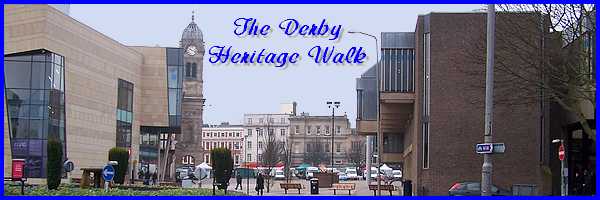
For the last three months our visits to Derby to
continue this Heritage Walk have seen us take a leisurely stroll
through The Arboretum but in this part we will leave the trees
behind as we continue through the streets and the history of
Derby towards the railway station.
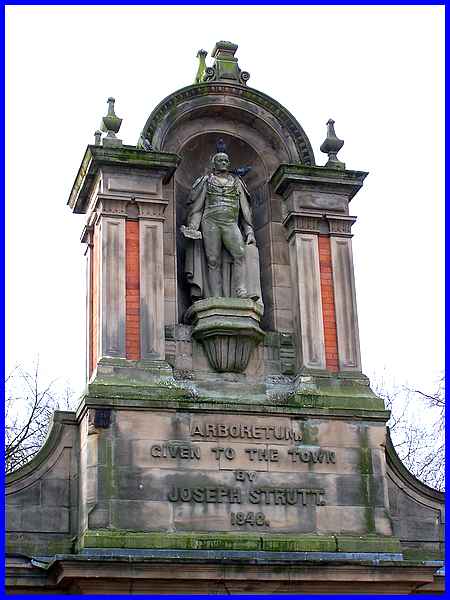
Our exit from the eleven acre park is overlooked by John Bell's
statue of Joseph Strutt who, as the inscription in the stonework
beneath shows, donated what was the world's first public park
to the town in 1840. Joseph who had accumulated his wealth from
industrial activities was one of the great social reformers of
the time and was the youngest son of Jedidiah, the well known
cotton manufacturer.
|
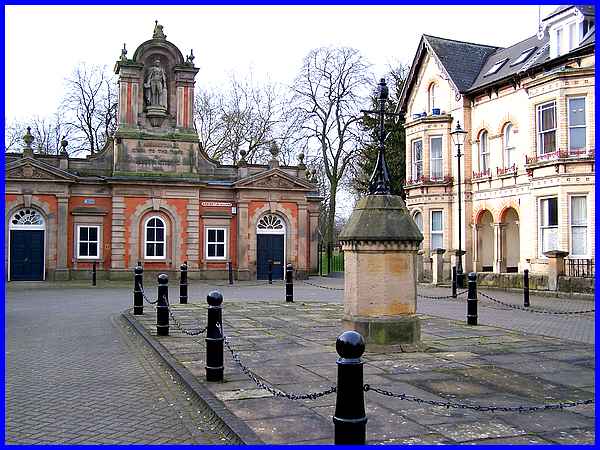
Strutt's statue stands above the Entrance Lodge that was built
in 1850, ten years after the opening of the Arboretum. It was
originally intended that there would be only two entrances to
the Arboretum but the construction of this lodge which was destined
to become the main entrance brought the number to four. The listed
Grade II lodge was by Henry Duesbury and it was restored in 1994
by the Derby Historic Buildings Trust. A successful bid to the
Heritage Lottery Fund has allowed work to be undertaken to restore
both the Arboretum itself and the lodges to their former glory
and it still continues today. This view of the Entrance Lodge
also shows, in the foreground, an iron lamp standard on a large
octagonal stone. This too is Grade II listed.
|
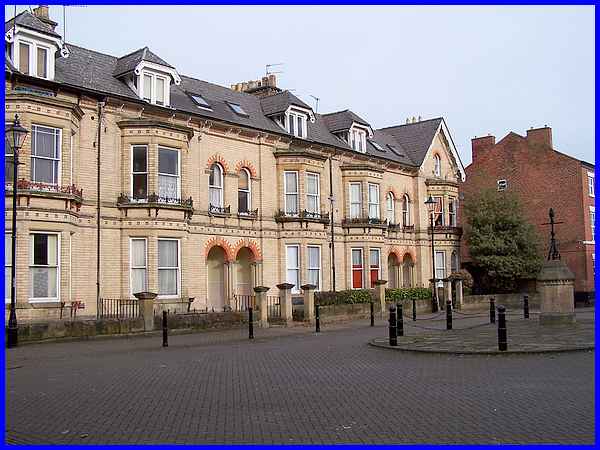
The lamp standard, also seen here on the right, stands on a paved
area in the middle of Arboretum Square where houses were built
on either side between 1867 and 1868. More recently these large
Victorian family homes were allowed to fall into a state of dereliction
but some have now been renovated and work is currently being
lovingly undertaken on others, retaining and restoring original
features, to convert them into apartments.
|
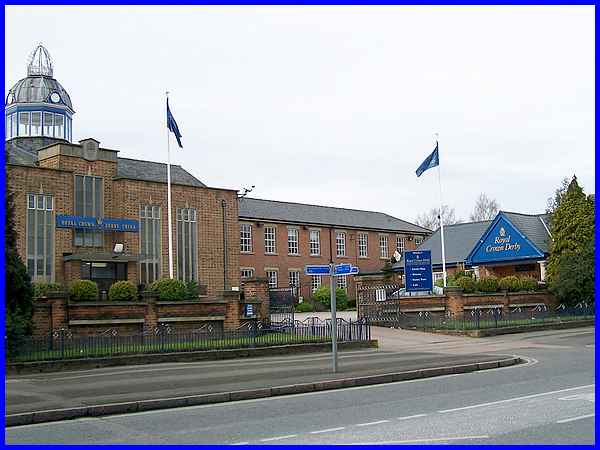
Just before the Arboretum opened in 1840, on an adjacent plot
and seen here from Osmaston Road, the Union Workhouse was built
to a design of John Mason in 1838 and 1839. It was adapted by
F. J. Robinson in 1877 - 78 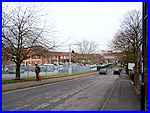 to
become the Crown Derby Porcelain Company where it has remained
to this day. Now with the "Royal" prefix, the company
was established by Edward Phillips and William Litherland. Producing
mementos for last year's Royal Wedding, the company had a profitable
year and are engaged in a similar project this year for the Diamond
Jubilee but back in 2002 it was their normal range of china that
was on display when we toured the factory and you can see images
from that visit by clicking here. On this occasion however we
continued on our walk by following Keble Close (right) and Oxford
Street to reach London Road. to
become the Crown Derby Porcelain Company where it has remained
to this day. Now with the "Royal" prefix, the company
was established by Edward Phillips and William Litherland. Producing
mementos for last year's Royal Wedding, the company had a profitable
year and are engaged in a similar project this year for the Diamond
Jubilee but back in 2002 it was their normal range of china that
was on display when we toured the factory and you can see images
from that visit by clicking here. On this occasion however we
continued on our walk by following Keble Close (right) and Oxford
Street to reach London Road.
|
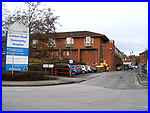 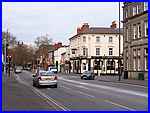 Off Oxford Street is an entrance
to the new London Road Community Hospital (left) which occupies
the site of the former Derby Royal Infirmary. We shall see more
of the DRI buildings in a later part but the Community Hospital
now provides rehabilitation and intermediate care. Turning left
onto London Road (right) our route first is to turn right at
the traffic lights into Midland Road. Off Oxford Street is an entrance
to the new London Road Community Hospital (left) which occupies
the site of the former Derby Royal Infirmary. We shall see more
of the DRI buildings in a later part but the Community Hospital
now provides rehabilitation and intermediate care. Turning left
onto London Road (right) our route first is to turn right at
the traffic lights into Midland Road.
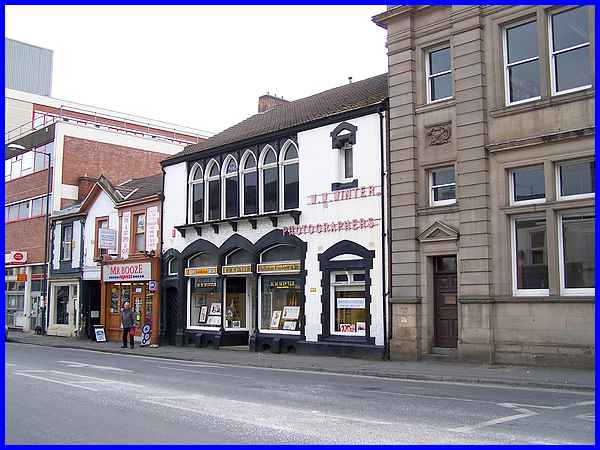
Just inside Midland Road is the distinctive facade of Winter's
Photographic Studio. the Winter in question being Alderman W.
W. Winter who had the premises built in 1867 after taking over
a business started ten years earlier. It is thought that the
building was designed by his friend, Henry Isaac Stevens (1806-1873)
and it is the earliest purpose built photographic studio to survive
in continuous use in the U.K.
|
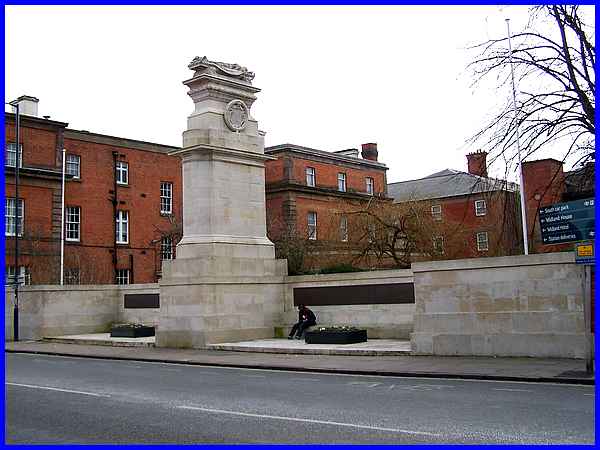
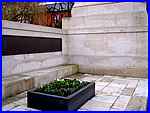 A little
further along Midland Road is the Midland Railway War Memorial
which was designed by Sir Edwin Lutyens and was originally dedicated
in December 1921 to commemorate “2,833 brave men of the
Midland Railway staff who gave their lives in the Great War.”
With the high price being paid for scrap metal the memorial was
the target in August 2010 for thieves who removed some of the
bronze plaques containing the names of the fallen. Fortunately
the stolen plaques were discovered nearby and following an £18,000
restoration by Network Rail and the Railway Heritage Trust the
memorial was rededicated in December 2010. A little
further along Midland Road is the Midland Railway War Memorial
which was designed by Sir Edwin Lutyens and was originally dedicated
in December 1921 to commemorate “2,833 brave men of the
Midland Railway staff who gave their lives in the Great War.”
With the high price being paid for scrap metal the memorial was
the target in August 2010 for thieves who removed some of the
bronze plaques containing the names of the fallen. Fortunately
the stolen plaques were discovered nearby and following an £18,000
restoration by Network Rail and the Railway Heritage Trust the
memorial was rededicated in December 2010.
|
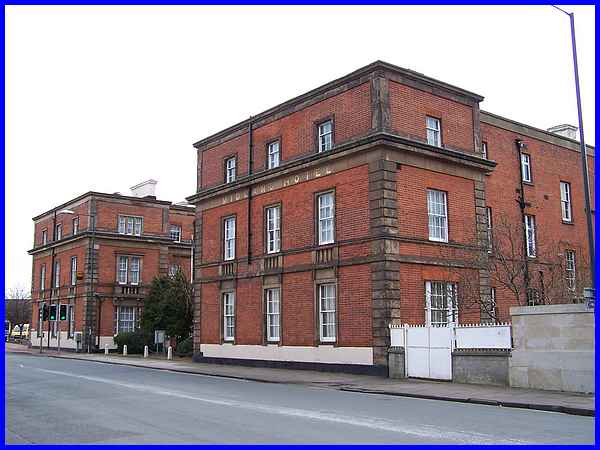
Next to the Railway War Memorial is the Midland Hotel that opened
in 1841 for the ‘Accommodation of the Gentry and Nobility’.
The Midland Hotel therefore was initially for first class passengers
whilst another hostelry (that we shall see in the next part)
the Brunswick Inn was for second class passengers and railway
workers. Among those first class visitors to the Midland in the
1840s was Queen Victoria who visited several time and stayed
in a suite of rooms that was made for her.
|
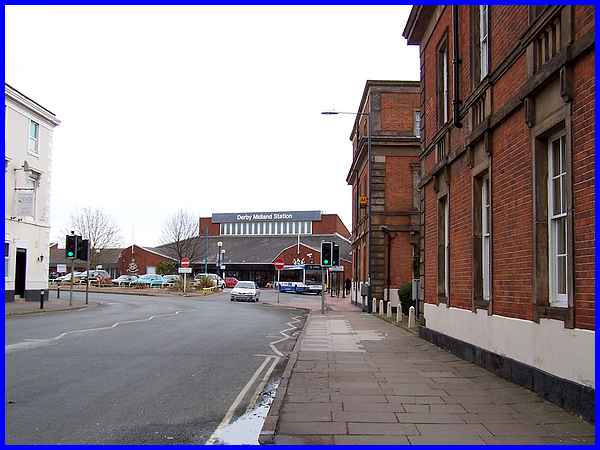
In the early days of the railway, travellers whether first or
second class could arrive at Derby Station on trains operated
by one of three companies. The North Midland Railway that was
formed in the 1830s ran north to Leeds whilst the Midland Counties
operated from Nottingham and Leicester. With the Birmingham and
Derby Railways also arriving, Derby became an important railway
town and the Midland Hotel opened opposite the station.
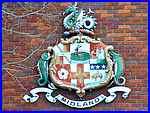
Both the station and the hotel were designed by Francis Thompson
and although much of his work at the station has disappeared
the hotel still stands as testament to his design. The three
companies amalgamated in 1844 to form the Midland Railway and
the coat of arms (right) that features the Wyvern of Mercia and
the shield incorporating the crests of the places served by the
company, Birmingham, Bristol, Derby, Leeds, Leicester and Lincoln
is still prominent on the station despite its obvious modernisation.
|

